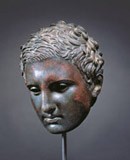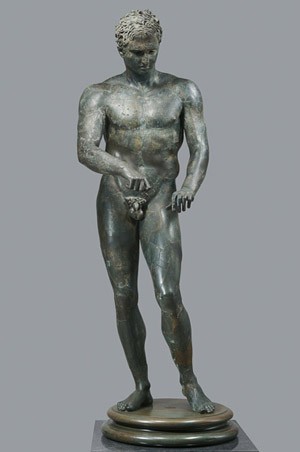Unique as most ancient bronzes now appear, many were never intended as “originals” in the modern sense of the word. The practice of casting statues in reusable molds facilitated the production of multiple bronze versions of the same work. Although few survive today, bronze replicas were the norm in antiquity. Statues honoring victorious athletes, for instance, were likely commissioned in an initial edition of two: one to be dedicated in the sanctuary where the competition was held and the other for display in the winner’s proud hometown.
Apoxyomenos and the Art of Replication
Athletes competed nude and coated their bodies with oil, making them glisten. The figure of an athlete holding a strigil (a curved blade used to scrape oil and dirt off the skin) is referred to as an Apoxyomenos, Greek for “scraping himself.” The statue of an Apoxyomenos on view was discovered in 1896 during excavations at Ephesos (present-day Turkey). The bronze head on loan from Fort Worth replicates that of the full-length sculpture from Ephesos and would have been created for a comparable statue. These two images of scrapers are not, however, first editions, but late Hellenistic or early Roman imperial copies of a statue created in the 300s BC. That work was probably made by a prominent sculptor, perhaps Lysippos, and was so famous that it was still reproduced centuries later. An additional nine replicas in marble and one in basanite (on view) further attest to its fame.
Pictured Above: Head of an Athlete ("Ephesian Apoxyomenos Type"), 200 – 1 BC; bronze and copper. Lent by the Kimbell Art Museum, Fort Worth, Texas
Pictured Left: Athlete ("Ephesian Apoxyomenos"), AD 1 – 90; bronze and copper. Lent by the Kunsthistorisches Museum Wien, Antikensammlung

